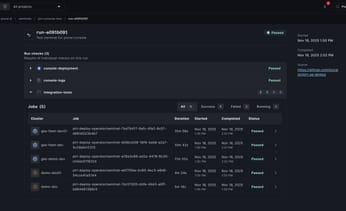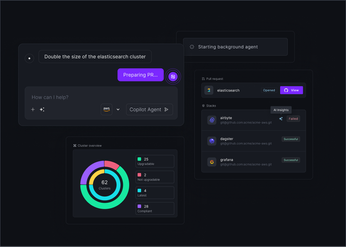
Kubernetes Fleet Management Best Practices
Learn Kubernetes fleet management best practices to efficiently manage multiple clusters, ensuring consistency, security, and scalability across your infrastructure.
Kubernetes promises speed and simplicity—but that promise starts to break down when you're managing dozens or hundreds of clusters. Manual workflows that worked for a few clusters quickly lead to chaos at scale. You run into configuration drift: clusters that were once identical start to behave differently over time. Critical security patches get applied in one region but are missed in another, introducing invisible vulnerabilities. Deployments that should be routine become risky and unpredictable. To bring order back, you need a structured approach.
This guide covers the key best practices for managing Kubernetes fleets at scale, helping you standardize configuration, enforce policy, and deploy safely across environments.
Unified Cloud Orchestration for Kubernetes
Manage Kubernetes at scale through a single, enterprise-ready platform.
Key takeaways:
- Standardize with a single source of truth: Define all cluster and application configurations as code in a Git repository. This practice eliminates configuration drift and creates a repeatable, auditable foundation for every environment in your fleet.
- Automate everything from deployment to security: Replace manual processes with automated pipelines for continuous deployment, policy enforcement, and resource scaling. Automation reduces human error and frees your team to focus on strategic work instead of repetitive maintenance.
- Unify management with a single control plane: Consolidate fleet management into one platform to gain complete visibility and control. A unified dashboard simplifies security, monitoring, and cost optimization across all clusters, regardless of where they run.
What Is Kubernetes Fleet Management?
Kubernetes fleet management is the practice of operating multiple clusters—often across clouds, regions, or environments—as one coordinated system. As teams scale, they outgrow single-cluster setups. Each cluster might serve a different app, team, or lifecycle stage, and without a unified approach, managing this sprawl becomes error-prone and inefficient.
The key principle is to treat clusters like cattle, not pets. Instead of hand-tuning each one, you manage them programmatically: provisioning, updating, and retiring them through automation. This shift is essential in microservices-heavy environments, where infrastructure must scale fast and stay consistent. Done right, fleet management gives you a standardized deployment pipeline, centralized config management, and better visibility, making the platform reliable for developers.
Why It Matters
Managing clusters individually doesn't scale. Inconsistent configs, unpatched vulnerabilities, and fractured workflows quickly become the norm—slowing delivery and increasing risk. Fleet management brings structure. It helps enforce policies, streamline deployments, and ensure that services behave the same in staging, production, or across regions. That consistency is critical for both velocity and security.
By treating your fleet as a single system, platform teams can deliver a reliable, hardened Kubernetes environment—so devs can ship faster without worrying about what cluster they’re on.
Common Challenges
Without a fleet-wide strategy, platform teams hit the same pain points:
- Configuration drift: Clusters that should be identical diverge over time due to manual tweaks or emergency fixes, making updates unpredictable.
- Security gaps: Each new cluster widens the attack surface. Managing RBAC, network policies, and secrets at scale without automation is a major risk.
- Operational overload: Time spent fixing broken clusters or untangling differences eats away at productivity.
An agent-based model or control plane federation helps address these issues—centralizing policy enforcement while preserving autonomy at the cluster level.
Standardize Your Cluster Configurations
Without standardization, managing multiple Kubernetes clusters becomes chaotic. Configuration drift creeps in, environments become fragile, and operational overhead rises. A consistent baseline across your fleet is the foundation for scalable and secure infrastructure.
To achieve this, treat everything—from cluster provisioning to app deployment—as code. Define your configurations with Infrastructure as Code (IaC), use reusable templates, and enforce policies. Combine this with a GitOps workflow to make changes traceable, consistent, and automated.
Use Infrastructure as Code
IaC means defining your infrastructure using config files, not manual steps. Tools like Terraform let you declare your cloud resources and Kubernetes infrastructure in code that’s versioned in Git. This makes your setups reproducible, reviewable, and easy to roll back.
If you’re managing dozens of clusters, IaC becomes critical. Tools like Plural Stacks simplify Terraform by providing a Kubernetes-native layer for running and organizing IaC workflows across clusters. This lets you target specific clusters declaratively, ensuring changes are applied consistently and safely across your fleet.
Create Reusable Templates and Enforce Policies
IaC also lets you create reusable templates for things like cluster blueprints, base workloads, or security settings. Instead of rewriting YAML for every deployment, you apply a known-good configuration.
To enforce quality and compliance, layer in policy tools like Open Policy Agent (OPA) or Kyverno. These can validate things like encrypted volumes, resource limits, or namespace restrictions before changes go live.
Plural’s self-service workflows help here too—developers can deploy using standardized manifests from a UI, reducing mistakes and freeing up platform engineers.
Adopt GitOps Principles
GitOps makes Git the source of truth for your infrastructure and applications. Developers open pull requests to propose changes, which are reviewed and automatically synced to live clusters. No kubectl access required.
This model improves security, makes changes auditable, and keeps all clusters in sync with declared config.
Tools like Argo CD and Flux power GitOps, but Plural CD takes it further with an agent-based architecture that continuously reconciles Git state with what's running on each cluster, helping you maintain consistency across your entire fleet.
Automate Your Fleet Management
Manual operations don’t scale. As your Kubernetes footprint grows, so do the risks: configuration drift, inconsistent deployments, and security gaps. Automation is the only way to manage a growing fleet with consistency and reliability, while freeing engineers from tedious maintenance.
By automating deployment pipelines, enforcing policies, and consolidating your tooling, you ensure every cluster remains compliant, up-to-date, and secure.
Set Up Continuous Deployment Pipelines
Applying changes manually to dozens of clusters is error-prone and time-consuming. A strong Continuous Deployment (CD) pipeline lets you roll out updates from a single source of truth, typically a Git repository.
This model improves consistency and auditability. Every cluster is updated based on the same declarative manifests, reducing the chances of drift.
Plural CD uses a GitOps-based, agent-driven model to sync workloads automatically. Its agents operate securely across cloud, on-prem, or edge environments—without requiring inbound access to your clusters.
If you prefer other GitOps tools, consider Argo CD or Flux for similar continuous delivery capabilities.
Enforce Governance with Policy Engines
Automation isn’t just for deployments—it’s critical for enforcing compliance at scale.
Tools like Open Policy Agent (OPA) and Kyverno let you define policies that are automatically applied to your workloads. You can prevent privileged containers, enforce resource limits, require cost-tracking labels, and more—all without manual review.
Plural’s PR automation API builds on this by generating policy-compliant manifests as part of your workflow, ensuring every deployment starts off secure and standards-compliant.
Consolidate Your Automation Tooling
While you could assemble your own toolkit—Terraform for infrastructure, Argo CD for deployments, Prometheus for monitoring—it adds operational complexity.
Many teams are moving toward integrated platforms that handle fleet-wide operations in one place. Look for tools that combine infrastructure management, deployments, and observability through a single control plane.
Plural is one such platform. It unifies continuous delivery, Infrastructure as Code, and secure Kubernetes management into one interface. That gives you consistent control, better visibility, and a simpler workflow across your entire fleet.
Secure Your Kubernetes Fleet
Scaling Kubernetes means scaling your attack surface. A single misconfigured cluster can compromise your whole platform if security isn't enforced fleet-wide. To stay ahead of threats, you need a consistent, automated strategy that covers access control, network security, dependency management, and auditability.
A centralized management plane helps you apply security policies uniformly, reducing human error, simplifying compliance, and improving your overall security posture.
Enforce RBAC Across the Fleet
Role-Based Access Control (RBAC) is essential for applying least-privilege access to Kubernetes resources. But defining and maintaining RBAC policies manually across multiple clusters doesn’t scale.
Plural integrates with your existing OIDC provider to support Single Sign-On (SSO) and centralized role management. You can define ClusterRoleBindings that map identity provider groups to Kubernetes roles, then use Plural Global Services to propagate these configurations automatically across your fleet.
This ensures consistent access control, simplifies audits, and eliminates manual drift between environments.
Apply Network Policies and Pod Segmentation
Kubernetes' default networking model allows unrestricted pod-to-pod communication. Without NetworkPolicies, one compromised pod can easily pivot across your cluster.
Define strict network policies to control traffic between namespaces, workloads, or labels. This limits lateral movement and enforces workload isolation.
Plural’s agent-based architecture enhances network security by eliminating the need for direct inbound access to your clusters. Its agents connect via egress-only channels to the control plane, making it possible to manage private or on-prem clusters securely, without setting up VPNs or exposing the API server.
Secure Third-Party Software Dependencies
Most Kubernetes setups rely on dozens of open source components, from ingress controllers to observability stacks. Each of these introduces potential vulnerabilities, such as Log4Shell.
Manual patching across clusters is time-consuming and risky. With Plural CD, you can automate the rollout of patched versions across all environments from a single Git repository. This ensures consistency, reduces exposure time, and simplifies CVE management.
GitOps also helps standardize how updates are reviewed, tested, and applied—making your entire software supply chain more secure.
Audit Everything via GitOps
Security isn’t just about prevention—it’s about traceability. Regular audits help detect issues, prove compliance, and understand the root cause of incidents.
Manual auditing across clusters is messy. A GitOps workflow, where every change is tracked through pull requests, gives you a clear, versioned audit trail by default.
Plural’s workflow turns infrastructure and application changes into reviewable, immutable commits. You get full visibility into who changed what, when, and why—making it easier to pass audits, perform forensic analysis, and meet security certifications like SOC 2 or ISO 27001.
Monitor Your Entire Fleet
Scaling Kubernetes from one cluster to many introduces monitoring complexity that siloed tools can’t solve. If each cluster has its own observability stack, incident response becomes guesswork—engineers scramble between dashboards, logs, and metrics without a unified view.
To maintain uptime and performance at scale, you need a fleet-wide observability strategy. Treat your entire fleet as a single system. That’s how you move from reactive firefighting to proactive optimization.
Centralize Logs and Metrics
A fundamental step is to aggregate logs and metrics from all clusters into a centralized observability platform like Grafana Loki, Prometheus, or OpenTelemetry Collector.
When observability data is scattered, even minor incidents can turn into lengthy outages. Centralization allows your team to:
- Correlate events across clusters
- Spot fleet-wide trends and anomalies
- Quickly identify the blast radius of issues
With Plural, you can deploy observability stacks across your clusters using GitOps and ensure they send logs and metrics to a common backend—whether that's a managed platform or self-hosted system.
Implement Distributed Tracing
Metrics tell you what is slow. Logs tell you what happened. But in distributed systems, only tracing tells you why.
In a microservices environment, a single user request may hop across dozens of services and clusters. Distributed tracing with tools like OpenTelemetry or Jaeger allows you to:
- Trace the full path of a request across services
- Identify latency bottlenecks
- Detect hidden service dependencies
Tracing reveals system behavior that metrics and logs alone can’t. It gives you context—and that context is critical when debugging incidents or optimizing performance.
Create a Unified Dashboard
Collecting data isn’t enough. Your team needs real-time, consolidated visibility—not just during incidents, but every day.
A unified dashboard combines logs, metrics, and traces into one interface. It should:
- Surface alerts and fleet-wide health indicators
- Enable drill-down into specific clusters or workloads
- Support SSO and RBAC so access is scoped and secure
Plural simplifies this with a built-in Kubernetes dashboard that works across all managed clusters. It uses Kubernetes impersonation and your identity provider for secure access—no need to manage kubeconfigs or expose APIs.
Your team gets a consistent, secure entry point to every cluster—whether public, private, or on-prem.
Scale and Optimize Your Fleet
As your Kubernetes footprint grows, so do the challenges of maintaining performance and controlling costs. Scaling isn’t just about adding more nodes—it’s about optimizing how resources are allocated across your entire fleet. Without clear visibility and governance, teams often end up with overprovisioned clusters that waste money, or underprovisioned workloads that degrade performance.
For example, one misconfigured cluster might aggressively consume compute while another suffers from memory starvation, crashing critical services.
To operate efficiently at scale, you need centralized control over:
- Autoscaling policies
- Resource limits
- Cost tracking and optimization
Platforms like Plural provide a unified control plane to implement these practices across clusters, helping teams move from reactive firefighting to proactive infrastructure optimization.
Develop a Cluster Autoscaling Strategy
Autoscaling is essential for balancing cost and performance. Manual resource tuning doesn’t scale and often leads to inefficient usage.
Use Kubernetes-native tools like:
- Horizontal Pod Autoscaler (HPA) to scale pods based on CPU/memory usage or custom metrics
- Vertical Pod Autoscaler (VPA) to adjust resource requests for individual pods
These tools help ensure apps have enough resources during traffic spikes and scale down when idle. A centralized dashboard that aggregates resource usage across clusters makes it easier to fine-tune autoscaling policies for maximum efficiency.
Manage Resource Quotas
In multi-cluster environments—especially those with multiple teams or workloads—resource contention is a real risk. Without controls, a single namespace can consume disproportionate compute, affecting other services.
Kubernetes provides two key primitives:
- ResourceQuota – sets max resource limits per namespace
- LimitRange – defines default/min/max CPU and memory per pod/container
Set these at the namespace level to prevent any one workload from overwhelming the system. Combined with centralized monitoring, you can track usage patterns and tune these policies to ensure fair and predictable resource distribution across your fleet.
Optimize Costs Across Clusters
Kubernetes makes it easy to spin up resources, but without automation and governance, costs can spiral quickly. Common culprits include:
- Idle workloads in non-production clusters
- Overprovisioned nodes and pods
- Configuration drift across environments
Automating cluster operations is key. With platforms like Plural, you can:
- Enforce consistent deployments using GitOps workflows
- Manage clusters and workloads via APIs and IaC tools like Terraform
- Track changes and identify cost leaks with an auditable infrastructure history
This reduces manual overhead, improves reliability, and makes it easier to align cluster resource usage with actual business needs.
Future-Proof Your Kubernetes Fleet
As the cloud-native landscape evolves, your fleet management strategy must evolve with it. The pace of change is relentless, with new tools, security threats, and architectural patterns emerging constantly. A forward-looking approach is no longer a luxury—it's a necessity for keeping your infrastructure resilient, scalable, and aligned with business goals. Failing to plan for the future can lead to significant technical debt, operational bottlenecks, and an inability to adopt technologies that could provide a competitive edge.
Future-proofing your Kubernetes fleet means designing for change from the outset. It involves building a management layer that is flexible enough to handle a distributed, heterogeneous environment while being robust enough to enforce standards and security across all clusters. According to the 2023 CNCF Annual Survey, Kubernetes adoption remains strong, but so do challenges around complexity and security. A modern fleet management strategy directly addresses these issues by treating geographically and technologically diverse clusters as a single, logical unit. This unified approach simplifies operations and prepares your organization for the next wave of innovation, whether that's adopting new cloud providers or integrating advanced AI/ML workloads.
Prepare for Multi-Cloud and Hybrid Deployments
Operating across multiple public clouds and on-premise data centers is becoming standard practice. This strategy helps avoid vendor lock-in, meets data residency requirements, and allows you to use best-of-breed services from different providers. The challenge, however, is managing these disparate clusters as a single, cohesive fleet. Each environment has its own APIs, networking rules, and security models, which can quickly lead to operational silos and inconsistent configurations.
A future-proof approach requires a management plane that can abstract away this underlying complexity. Plural’s agent-based architecture is designed for this reality. By installing a lightweight agent in each cluster—whether it's in AWS, GCP, or your own data center—you can manage your entire fleet from a single control plane without complex multi-cloud networking. This allows you to enforce consistent policies and deploy applications universally, treating your distributed infrastructure as one logical entity.
Adapt to Emerging Technologies
The Kubernetes ecosystem is constantly changing, with new tools and patterns emerging regularly. Manually managing clusters is not a scalable solution. DevOps and SRE teams are increasingly using specialized Kubernetes automation tools to streamline operations because a rigid, inflexible management platform can quickly become a bottleneck, preventing your team from adopting more efficient technologies. Your strategy should prioritize automation and extensibility to keep pace.
Plural is built around an API-driven, GitOps-centric model that promotes automation. Our PR automation capabilities allow developers to self-service infrastructure changes through a standardized, auditable workflow. This reduces the burden on platform teams and accelerates development cycles. Furthermore, Plural Stacks provide an API-driven way to manage Infrastructure as Code (IaC), making it easier to integrate new tools and automate complex provisioning tasks. This ensures your fleet management practices can adapt as your technology stack evolves.
Manage Your Fleet with Plural
Implementing the best practices for fleet management requires a platform that can unify disparate tools and workflows. Manual processes, ticket-based systems, and inconsistent configurations don't scale and introduce significant risk. Plural provides a unified control plane designed to address these challenges directly, offering a consistent, GitOps-driven workflow for managing Kubernetes applications and infrastructure at any scale. By integrating continuous deployment, infrastructure as code, and a secure dashboard into a single platform, Plural helps platform teams enforce standards while giving developers the self-service capabilities they need.
How Plural Solves Common Challenges
Plural provides a single pane of glass for your entire Kubernetes fleet, giving you a centralized view of clusters regardless of whether they are in the cloud, on-premises, or at the edge. This is achieved through a secure, agent-based architecture that eliminates the need for complex multi-cloud networking or managing countless kubeconfigs. The platform simplifies dependency management and upgrades for both Kubernetes and its add-ons, ensuring compatibility and stability. By abstracting away the underlying complexity, Plural enables more engineers to confidently perform management tasks, reducing the operational load on senior staff and eliminating talent bottlenecks.
Standardize, Automate, and Secure Your Fleet
Plural is built on GitOps principles to help you standardize and automate fleet management. With Plural Stacks, you can manage Terraform and other IaC tools through a Kubernetes-native, API-driven workflow, ensuring that all infrastructure changes are version-controlled and auditable. This allows you to create reusable, policy-compliant templates for cluster configurations. Security is managed through fine-grained access controls that integrate with your existing identity provider. The embedded Kubernetes dashboard uses impersonation, meaning you can define RBAC policies as code in Git and have them apply consistently across the entire fleet, securing your clusters by default.
Related Articles
- Kubernetes Multi-Cluster: The Ultimate Guide (2024)
- Your Guide to Kubernetes Cluster Management
- Managing Kubernetes Deployments: A Comprehensive Guide
- Kubernetes Cluster Security: A Deep Dive
- Top Kubernetes Management Tools to Simplify K8s
Unified Cloud Orchestration for Kubernetes
Manage Kubernetes at scale through a single, enterprise-ready platform.
Frequently Asked Questions
What's the biggest risk of not having a formal fleet management strategy? The biggest risk is that your clusters become inconsistent. Without a central strategy, each cluster slowly drifts from its original configuration due to manual fixes and team-specific changes. This makes your entire system brittle and unpredictable. When you need to apply a critical security patch or deploy a new application, you can't be sure it will work the same way everywhere. This inconsistency complicates troubleshooting, introduces security gaps, and ultimately slows your teams down as they spend more time fighting fires than building features.
How does GitOps actually solve the problem of configuration drift across many clusters? GitOps establishes your Git repository as the single source of truth for the state of your entire fleet. An automated agent runs inside each cluster and continuously compares the live configuration to what's defined in your repository. If it detects any discrepancy—whether from a manual hotfix or an accidental change—the agent automatically reverts the cluster back to the state defined in Git. This creates a self-healing system that enforces consistency, ensuring every cluster in your fleet reliably mirrors the configuration you've committed and reviewed.
My clusters are spread across different clouds and some are on-prem. How can I manage them without complex networking? This is a classic challenge that is best solved with an agent-based architecture. Instead of a central management tool trying to connect into each cluster—which would require complex firewall rules, VPNs, and credentials for each environment—a lightweight agent is installed inside each cluster. This agent initiates a secure, egress-only connection out to the central control plane. This model allows you to securely manage and monitor all your clusters from a single location, regardless of where they run, without ever exposing their API servers to the internet.
How can I enforce the same access rules (RBAC) everywhere without manually updating each cluster? You can do this by managing your RBAC policies as code within a Git repository. With a platform like Plural, you can define a GlobalService that points to your RBAC configurations. This service then automatically synchronizes those policies across every cluster in your fleet. When you need to grant a new team access or update a permission, you simply modify the policy in your Git repository. The change is then reviewed, merged, and rolled out automatically, ensuring consistent and auditable access control everywhere.
How does Plural help my developers provision resources without waiting on the platform team? Plural enables developer self-service through pull request automation. A developer can use a simple UI to request a new resource by providing a few basic inputs. Plural then automatically generates the standardized Infrastructure as Code (IaC) configurations and opens a pull request. This allows the platform team to simply review and approve the request, rather than writing the code from scratch. The entire process is transparent and auditable, giving developers the speed they need while ensuring all infrastructure adheres to organizational standards.
Newsletter
Join the newsletter to receive the latest updates in your inbox.









